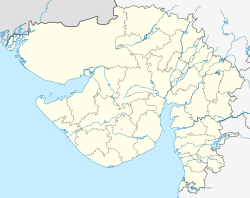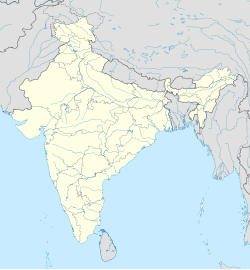Sack of Somnath
| Sack of Somnath | |||||||
|---|---|---|---|---|---|---|---|
| Part of Ghaznavid campaigns in India | |||||||
 Ruins of Somnath as viewed in 1869 | |||||||
| |||||||
| Belligerents | |||||||
| Ghaznavids | Chaulukya dynasty | ||||||
| Commanders and leaders | |||||||
| Mahmud of Ghazni | Bhima I | ||||||
| Strength | |||||||
|
30,000 cavalry Unknown number of volunteers[2][3] | 20,000[4] | ||||||
| Casualties and losses | |||||||
| Unknown | 50,000 deaths | ||||||
Location within Gujarat | |||||||
The Sack of Somnath in 1025-1026[5] was a military campaign orchestrated by Mahmud of Ghazni, a ruler of the Ghaznavid Empire, directed against the Chaulukya dynasty of Gujarat. This is considered Mahmud's fifteenth invasion of India, which saw strategic captures and decisive battles and culminated in the destruction of the revered Somnath Temple. Facing staunch resistance, Mahmud's forces emerged victorious, resulting in significant casualties. Entering Somnath in mid-January, Mahmud looted and burned the temple, earning him the title ‘The Idol Breaker’. This event remains a historical symbol of cultural clash and religious desecration during Mahmud's military campaigns in medieval India.
Background
[edit]The Somnath Temple, situated in Veraval, Gujarat, India, is a sacred Hindu temple. In 1026, Gujarat was under the rule of King Bhima I from the Chalukya dynasty.[6] Mahmud of Ghazni conducted multiple attacks on Indian kingdoms during that era. Mahmud of Ghazni gained renown through campaigns in India, vassalizing the Gurjara Pratihara dynasty and overthrowing the Hindu Shahi dynasty. His successful campaigns against the Chandelas and other Hindu chiefs established him as a formidable figure among Indian kings.[7]
Historian Ibn al-Athir noted during Mahmud's invasion of Indian kingdoms the sultan destroyed idols and temples on his way. The Hindus said that Somnath was displeased with those idols and if it had been pleased with them then none could harmed them. When Mahmud heard this he decided to destroy the idol of Somnath.[2]
March towards Gujarat
[edit]On October 18, 1025, Mahmud of Ghazni embarked on a march from Ghazni, leading 30,000 cavalry. Each soldier was personally given two camels for essential resources like food and water. The Sultan himself loaded his arrangements with 20,000[2] or 30,000 camels.[3] On 26th November after a rest in Multan, they resumed their journey proceeding through the desert.
Mahmud initially seized the fort of Ludrava, near Chiklodara Mata, close to Palanpur which was capital of the Bhati Jadons.[4] He continued to march crossing the Jaisalmer state and Mallani. By the end of December, he reached Anhilwara, prompting its ruler, Bhima I, to flee to the fort of Kanthkot[a] in Kachchh upon hearing of the Ghaznavid approach, fearing for his life.[7][8]
Mahmud of Ghazni stationed his army at Patan, bolstering resources for the campaign. Moving southwards Mahmud reached at Mundhera[b], where the Hindus made a significant effort to halt the advance of the invading Muslim army. Approximately 20,000 warriors, rallied under their local chiefs, but were ultimately defeated and dispersed. Following this victory, the Sultan proceeded directly to Delvāda, near Unā, where the local population, believing the deity Somnath would divinely intervene to destroy the Muslim forces, offered little resistance. Consequently, Delvāda was captured with minimal opposition.[4] He then advanced towards Somnath, seizing the Somnath fort from Mandalika, the fort's overseer on 6 January 1026 AD.[8]
At Somnath
[edit]Known as his fifteenth invasion of India, Mahmud's Somnath expedition targeted the temple located in the southernmost part of Kathiawar. Mahmud laid siege on the fort of Somnath. The garrison, supported by Brahmins and devotees of the idol, defended. On Friday, 7th January, the Ghaznavids launched a fierce assault with a barrage of arrows, forcing the defenders to abandon the battlements. By the afternoon, during the Jumu'ah prayer time, the invading army scaled the walls and announced their success with the call to prayer. The Hindus retreated to the temple, prayed before the idol, and, with renewed resolve, launched a fierce counterattack, driving the Ghaznavid army from their captured positions by evening. On the third day of the battle, the Ghaznavid forces attacked, recaptured the fortifications, and drove the Hindus to the shrine's gates, where a fierce melee ensued. Although found themselves surrounded, yet they ultimately triumphed, defeating the Chalukyas and causing 50,000 casualties among the defenders.[10] Many tried to flee on boats but were slain or drowned by a guard posted along the sea coast.
Mahmud of Ghazni, upon entering the temple, plundered the idols and shattered the Shiva Linga into pieces. He extensively looted and razed the temple to the ground plundering 20,000,000 dinars.[11] This successful campaign earned Mahmud the title 'The Idol Breaker'.[10][12] Within a month, Mahmud departed Somnath for Ghazni, while facing numerous attacks from the Jats on the way.[13] In 1026 CE Mahmud conducted his last military engagement (16th invasion) as a naval attack near the Indus River, where Mahmud of Ghazni inflicted a severe defeat on the Jats, compelling them to retreat with substantial losses.[10]
Notes
[edit]References
[edit]- ^ Nazim 1931, p. 117.
- ^ a b c Nazim 1931, p. 115.
- ^ a b Munshi 1952, p. 35.
- ^ a b c d Nazim 1931, p. 116.
- ^ Nazim 1931, p. 252.
- ^ Majumdar 1956, pp. 40–60.
- ^ a b Sen 1999, pp. 353–355.
- ^ a b Munshi 1952, p. 36.
- ^ Nazim 1931, p. 218.
- ^ a b c Mehta 1979, pp. 58–59.
- ^ Nazim 1931, p. 117-118.
- ^ Jindal 1992, pp. 77–78.
- ^ Munshi 1952, pp. 37.
Sources
[edit]- Nazim, Muhammad (2014) [1931]. The Life and Times of Sultan Mahmud of Ghazna. Cambridge University Press. ISBN 978-1-107-45659-4.
- Munshi, Kanaiyalal Maneklal (1952). Somnath: The Shrine Eternal. Bharatiya Vidya Bhavan.
- Majumdar, Asoke Kumar (1956). Chaulukyas of Gujarat: A Survey of the History and Culture of Gujarat from the Middle of the Tenth to the End of the Thirteenth Century. Bharatiya Vidya Bhavan.
- Sen, Sailendra Nath (1999). Ancient Indian History and Civilization. New Age International. ISBN 978-81-224-1198-0.
- Jindal, Mangal Sen (1992). History of Origin of Some Clans in India, with Special Reference to Jats. Sarup & Sons. ISBN 978-81-85431-08-6.
- Mehta, Jaswant Lal (1979). Advanced Study in the History of Medieval India. Sterling Publishers Pvt. Ltd. ISBN 978-81-207-0617-0.
Further reading
[edit]- Eck, Diana L. (2012-03-27). India: A Sacred Geography. Harmony/Rodale/Convergent. p. 222. ISBN 978-0-385-53191-7.
- Jackson, Peter (2003-10-16). The Delhi Sultanate: A Political and Military History. Cambridge University Press. p. 195. ISBN 978-0-521-54329-3.
- Meisami, Julie (2003-09-02). Structure and Meaning in Medieval Arabic and Persian Lyric Poetry: Orient Pearls. Routledge. ISBN 978-1-135-79010-3.
- Sharma, R. S. (1992). A Comprehensive History of India: A.D. 985-1206. People's Publishing House. p. 358. ISBN 978-81-7007-121-1.
- Lal, Kishori Saran (1995). Growth of Scheduled Tribes and Castes in Medieval India. Aditya Prakashan. p. 29. ISBN 978-81-86471-03-6.


